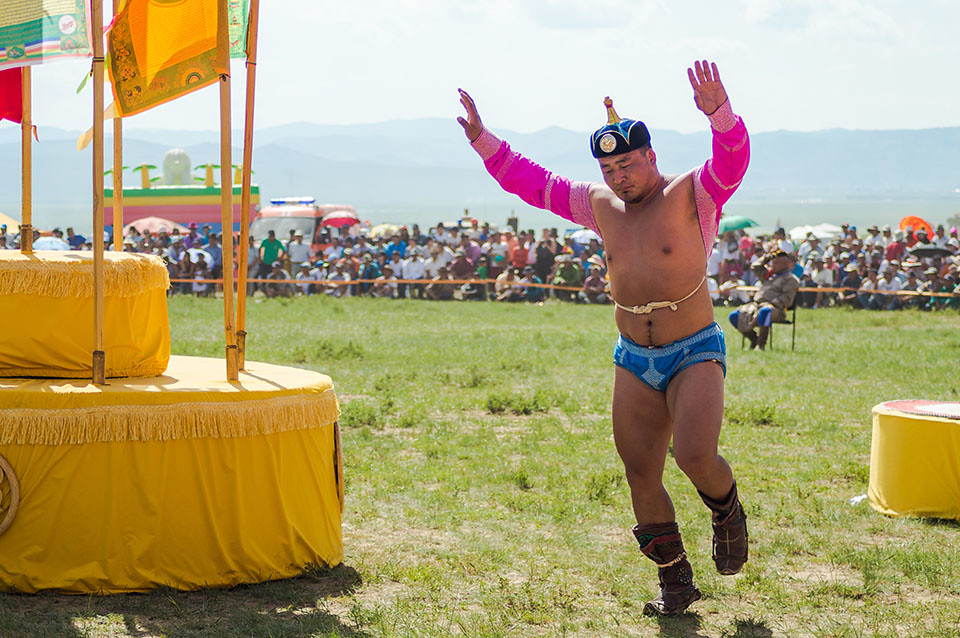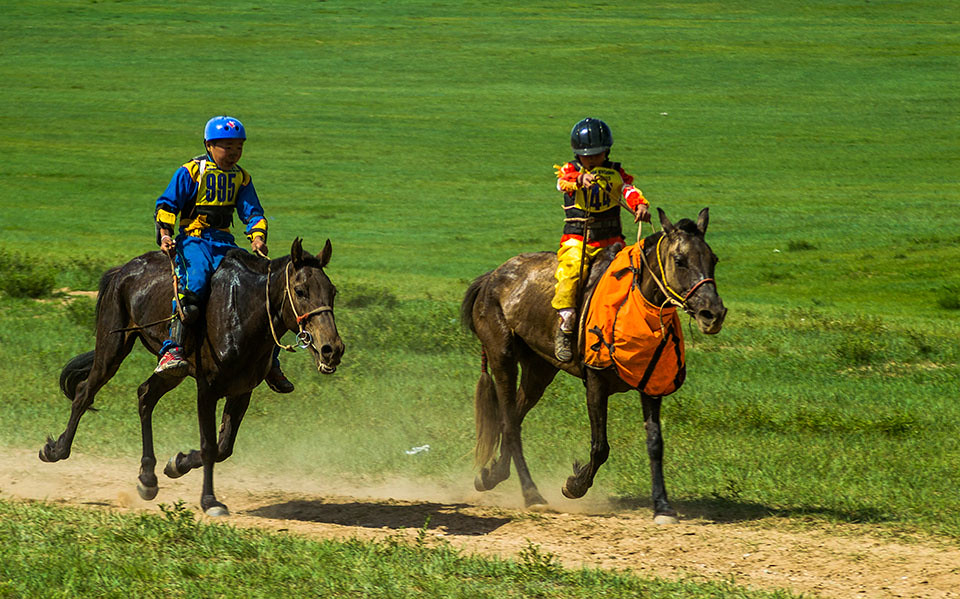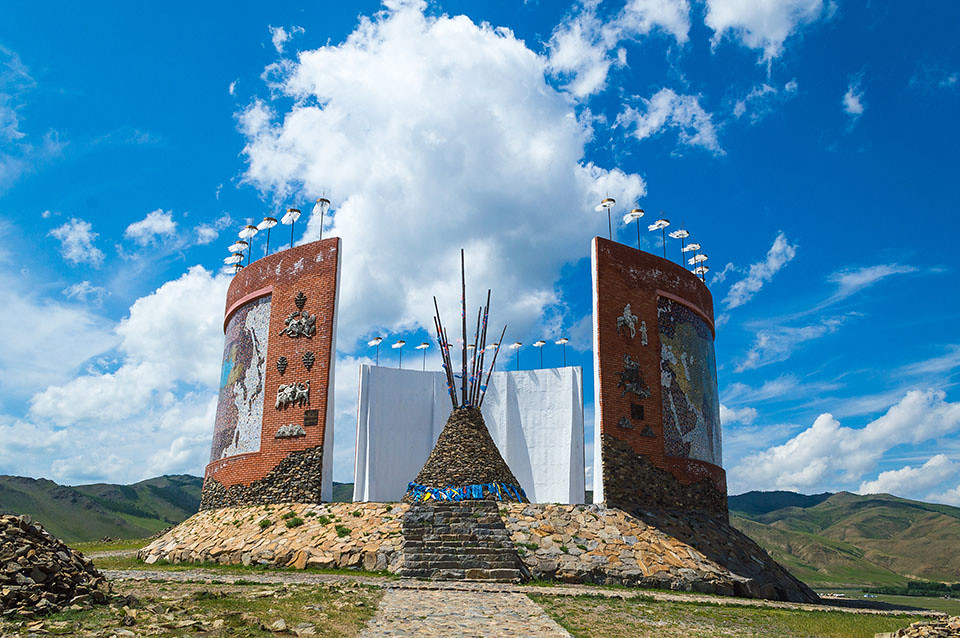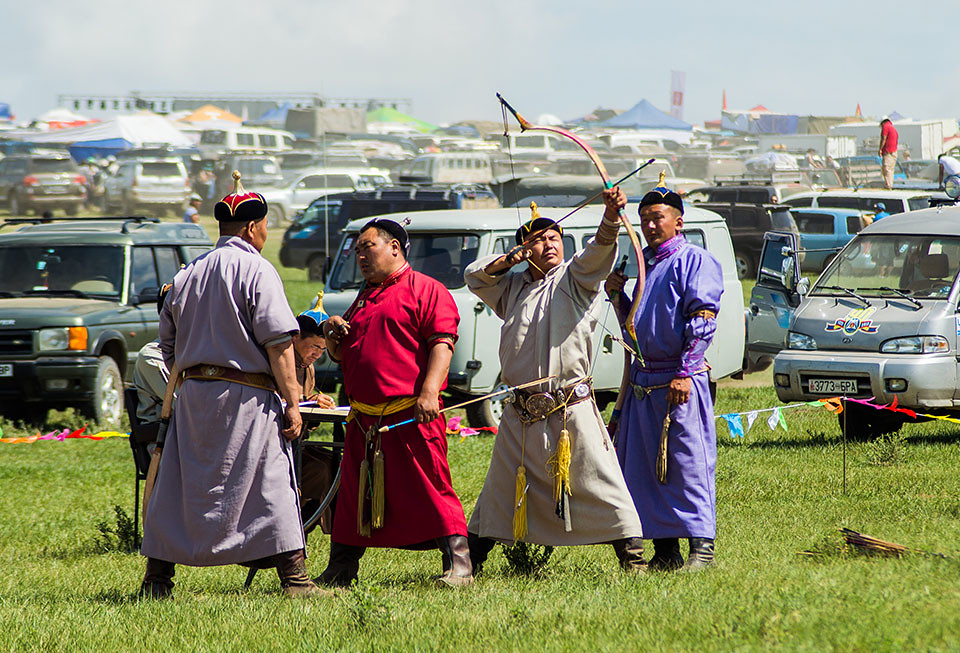- A local Mongolian guide who will escort the group throughout your tour.
- All meals as listed in itinerary
- Staying Tourist camp
- Sightseeing as per itinerary
- Accommodation in 4 stars hotel in Ulaanbaatar (twin standard room double occupancy)
- Transportations by 4WD vehicles
- Transfers between the airport and hotel
- Daily supply of bottled water
- Tours per the itinerary including entrance fees
Overland Discovery with Rural Naadam Festival in Karakorum (16 days / 15 nights)
DETAILED TOUR ITINERARY
Upon arrival at Chinggis Khan International Airport, you are met by your tour guide and transferred
to the hotel in the city center. The first stop is Sukhbaatar Square. This central square is named
after Damdiny Sukhbaatar, the revolutionary hero of 1921 who declared independence from China. Next
is a visit to Gandan Monastery, the largest and most famous functioning monastery in Mongolia. Here
you will see the impressive Golden
Buddha Statue of Migjid Janraisig and may even have the opportunity to experience monks in
worship. Time permitting; you will visit the Natural History Museum, which is famous for its
collection of authentic dinosaur skeletons found throughout Mongolia, and then take in a fantastic
view of the entire city from Zaisan memorial hill. End the evening with a welcome dinner at a local
restaurant.
Meals: Lunch and Dinner
Overnight in 4 star hotel
After breakfast drive to Amarbayasgalant through the Erdene city which is the biggest city in Mongolia make a short stop there. Late in the afternoon visit with monastery that’slocated in Selenge province, northwest of Mongolia, the biggest monastery in Mongolia after Erdene zuu monastery.
Amarbayasgalant monastery the monastery was established by order of Manju emperor Enkh- Amgalan Khan, to cherish and give respect to the Undur Geghen Zanabazar, his skills, wisdom, intellect and accomplishments.One hundred thousand langs (=3730 kg) of silver from the state fund were used to build a magnificently styled place for Buddha teaching and practice in honor of Zanabazar. After searching for a suitable place, the construction works of the monastery called “Amarbayasgalant a palace for God `s meditation, began in the year of red horse, 1726, and was completed in the year of red dragon, 1736. Out of deep respect the monastery was then offered to the Undur Geghen.
Meals: Breakfast, Lunch, Dinner
Overnight in tourist camp
After breakfast, we will drive to Ugii Lake, which is a fresh water lake in the steppe and rich with fish and bird life. We will have a leisurely afternoon walking around the lake, and enjoying some bird watching.
Meals: Breakfast, Lunch, Dinner
Overnight in tourist camp
Following breakfast at tourist camp, we will drive to Tsenher hot spring. Along the way we will stop for a break in the small town of Tsetserleg to visit a monastery museum. We spend overnight in a ger camp based at natural hot springs. Soak in hot water; enjoy a hike in the hills.
Meals: Breakfast, Lunch, Dinner
Overnight in the tourist camp
Today you have an opportunity to ride a horse and hot spring bathing and the opportunity to explore the surrounding area on foot.
Overnight in tourist camp,
Meals: Breakfast, lunch and dinner
In the morning we are heading to Karakorum where we will attend Rural Naadam Festival. During whole lovely day you enjoy watch Naadam festival or three manly sports such as wrestling, archery and horse racing. Visit opening ceremony of Naadam festival. And you will see archery, wrestling and horse racing during Naadam festival. Naadam festival is of the victory of the People’s Revolution. Mongolia celebrates its independence and its rich cultural heritage with a festival of sports and revelry in Ulaanbaatar. The distinctly Mongolian feel and flair of the Naadam Festival make it a wonderful spectacle, a joyous time, and an intriguing cultural event. Colorful ceremonies and parading soldiers kick off the celebrations. The ancient game of wrestling follows, with men competing in many rounds of competition. Both men and women compete in the archery games, using the traditional Mongolian compound bow that terrorized Europe when Genghis Khan andhis Golden Horde moved their empire west. The quintessentially Mongolian art of horse racing follows, where up to 800 horses compete, jockeyed by children so that the skill of the horse, and not the rider, is tested.
Overnight in Ger Camp with Deluxe ger with en-suite bathroom,
Meals: Breakfast, lunch and dinner
In Karakorum, we will visit Erdene-Zuu, the oldest monastery, with 108 stupas, built in 1586. The monastery was built of the remains of the ancient Mongolian capital. Ancient capital of Mongolia Karakorum city was located on the right bank of Orkhon River and on the north-eastern slopes of the Khangai Mountain and founded by Chinggis khan in 1220, was not only the capital of the vast Mongolian Empire but the epicenter of trade along the Silk Road. At that time the inhabitants of city were mostly Merchants craftsmen who came to Karakorum from all over the world. As Kublai khan moved the capital of the Mongolian Empire to China, establishing the Yuan Dynasty, began losing its importance. In 1379 much of the city was badly damaged during an attack by the army ofthe Min Dynasty.
Erdene Zuu Monastery was built by Avtai Sain Khan on the ruin of the Mongolian capitalKarakorum in 1586. It was the first great Buddhist Monastery of Mongolia. It is part of the World Heritage Site entitled Orkhon Valley Cultural Landscape. Stones from the ruins of Karakorum were used in construction. It is surrounded by a wall featuring 108 stupas, 108 being a sacred number in Buddhism, and the number of beads in a Buddhist rosary. The monastery was damaged by warfare in the 1680s, but was rebuilt in the 18th century and by 1872 had a full 62 temples inside. The Erdene Zuu Monastery was taken to state protection and became museum in 1944.
Next, we will visit the Karakorum Museum and see the Great Mongol state period, Stone Age, Bronze Age, Ancient state period halls.
Overnight in Ger Camp with Deluxe ger with en-suite bathroom
Meals: Breakfast, lunch and dinner
Today you'll drive to the ruins of the Ongi monastery. It was the largest Buddhist center in the Gobi region. There are 2 complexes of temple ruins which were built up in 1780s. During political repression in 1930s’ these two temples were destroyed and many lamas were executed and imprisoned. Visit Ruin of monastery reconstructed parts. On the way visit basin of the Ongi river which is dried out because of mining activity.
Overnight in tourist camp
Meals: Breakfast, lunch and dinner
After breakfast, we leave Hongoryn Els for Bayanzag. It's a long day drive today and can take up to 5
hours but it's a scenic drive through the vast land. We will occasionally stop for photography and
to watch the birds and the animals of the area. We check in our camp, wash and change and after
lunch, we drive to visit the Flaming Cliff. The place was named as 'Flaming Cliffs' by Roy Chapman
Andrews, an American explorer who searched throughout the Mongolian Gobi Desert and found dinosaur
skeleton and eggs for the first time in Asia. The red cliff gleams with sunlight and can be seen
from far away. We will take a short walk on the ridge of the cliff and look for the pieces of
Dinosaur bones. We will drive little further to see the saxaul trees that contributed the name
Bayanzag. Bayanzag means-rich in saxaul.
Overnight in Gobi Nomad Lodge – Deluxe ger
Meals: Breakfast, lunch and dinner
After breakfast, take in the stunning scenery of the Gobi-Altai Mountain range as you transfer to the towering sand dunes of Khongoryn Els, home to the ‘Singing Sands’. These spectacular dunes got their name from the noise made by the shifting sand in the wind. Feel the breeze in your hair as you ride a camel across the dunes before returning to the ger camp. Isolated from the rest of the country, the Singing Sands are the best kept secret for thousand years in the history of Mongolia.
Overnight in Ger camp
Meals: Breakfast, lunch and dinner
Today we will have a full day exploring the sand dunes and rest after the long drive. The dunes seem to stretch on forever like a soft ribbon of sand draped over the desert. The shifting sand blown by the wind or someone makes sound so it is called Singing Sand Dunes. There is a beautiful green oasis known as Seruun bulag near the Khongor River. Return to the camp for lunch and enjoy feeling silence and a peaceful in the beautiful surroundings Gobi Deserts.
Overnight in the Ger Camp
Meals: Breakfast, lunch and dinner
In the morning, we drive to Yol Valley. Learn about the local wildlife in the Natural History Museum before taking a gentle hike through the valley to discover their habitats. This valley is nestled deep within the hills and is a safe haven to get away from the desert heat. Some areas of the valley are continually sheltered from the hot sun and house huge, blocks of ice that gradually melt away during the summer. It is very wide at the entrance and narrows gradually into a remarkable gorge. You will get to see wild animals such as ibex and wild sheep, and the vulture. You can go horseback or camel riding around the area and go trekking to the gorge. Tonight is your first night in a traditional Mongolian ger camp
Overnight in Gobi Nomad Lodge – Deluxe ger
Meals: Breakfast, lunch and dinner
In the morning we drive to see the Khavtsgait Petroglyphs from the Bronze Age (4000-3000 BC) are
beautifully carved on several rocks on the top of a sacred mountain. The petroglyphs were carved and
painted with motifs consisting of various animals related to everyday life of ancient people
including deer, bears, wolves and hunters, and wolves with livestock. Other paintings depict
domestic scenes of yaks pulling carts, the wheels and horses flattened sideways like hieroglyphs,
and herders on horseback. The engravings vary in size, ranging from two-centimeters to the life-size
of horses.
Note: The area is very rocky and can be slippery to climb, but by wearing appropriate
shoes and carefully following the mountain path one can reach the top to see these beautiful rock
paintings.
We will visit a herder family nearby to learn about their unique daily lifestyle and see
them go about their daily chores like milking mares and goats or fencing. This is a
perfect opportunity for you to try fermented mare's milk and other dairy products.
Meals: Breakfast, Lunch, Dinner
Overnight in Gobi Nomad Lodge – Deluxe ger
Drive to Middle Gobi is known as Baga Gazriin chuluu (earth stone). You will be reachedin the early afternoon, lunch at the camp. There are some interesting granite rock formations, also there eye spa which supposed to be good for sights. There is ruin of ancient small temple, located middle of the rock.
Meals: Breakfast, Lunch, Dinner
Overnight in tourist camp
On your drive back to Ulaan Baatar, visit the Bogdo Khaan Winter Palace Museum. The Bogdo Khaan Winter Palace is the home of the last Mongolian King, Javzun Damba Khutagt VII. The museum contains a number of Buddhist artworks and the private collection of Bogdo Khaan, composed of gifts from rulers and kings from all over the world. The artworks displayed here were made by the top Mongolian, Tibetan, and Chinese master- sculptors of the 18th and 19th centuries and represent the gods of Buddhist pantheon. In the evening you can enjoy a farewell dinner and attend the local folklore dance shows.
Meals: Breakfast, Lunch, Dinner
Overnight in 4* hotel
Transfer to the airport for flight to next destination.












